
The German Navy is the navy of Germany and part of the unified Bundeswehr, the German Armed Forces. The German Navy was originally known as the Bundesmarine from 1956 to 1995, when Deutsche Marine became the official name with respect to the 1990 incorporation of the East German Volksmarine. It is deeply integrated into the NATO alliance. Its primary mission is protection of Germany's territorial waters and maritime infrastructure as well as sea lines of communication. Apart from this, the German Navy participates in peacekeeping operations, and renders humanitarian assistance and disaster relief. It also participates in anti-piracy operations.

The Republic of Singapore Navy (RSN) is the naval service branch of the Singapore Armed Forces (SAF) responsible for defending the country against any sea-borne threats, and the protection of its sea lines of communications, that would compromise Singapore as a global trading hub. The RSN traces its origins to the Royal Navy when Singapore was still a Crown colony of the British Empire. After Singapore's independence from Malaysia in 1965, the service was formally established in 1967, and had undergone a substantial modernisation ever since—which led them into becoming the most powerful navy in Southeast Asia.

The Commander-in-Chief Fleet (CINCFLEET) was the admiral responsible for the operations of the ships, submarines and aircraft of the British Royal Navy from 1971 until April 2012. The post was subordinate to the First Sea Lord, the professional head of the Naval Service. In its last years, as the Navy shrank, more administrative responsibilities were added.
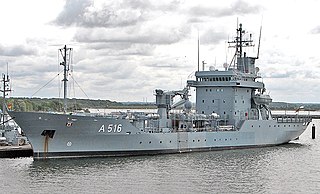
The Type 404 Elbe-class replenishment ships of the German Navy were built to support its squadrons of Fast Attack Craft, submarines and minesweeper/hunters, as such they are usually referred to as tenders.

The Type 332 Frankenthal-class minehunter is a class of German minehunters. The ships are built of non-magnetic steel. Hull, machinery and superstructure of this class is similar to the original Type 343 Hameln-class minesweeper, but the equipment differs.

The Bulgarian Navy is the navy of the Republic of Bulgaria and forms part of the Bulgarian Armed Forces. It has been largely overlooked in the reforms that Bulgaria had to go through in order to comply with NATO standards, mostly because of the great expense involved and the fact that naval assaults are not considered to be a great concern for the country's security. That is why three of the four Romeo-class submarines are now docked and have been out of operation for some time. The last one was decommissioned in November 2011. Only the more modern frigates, corvettes and missile crafts are on active duty.
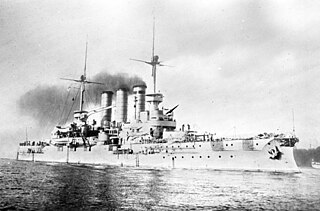
SMS Braunschweig was the first of five pre-dreadnought battleships of the Braunschweig class built for the German Kaiserliche Marine. She was laid down in October 1901, launched in December 1902, and commissioned in October 1904. She was named after the Duchy of Brunswick. The ship was armed with a battery of four 28 cm (11 in) guns and had a top speed of 18 knots. Like all other pre-dreadnoughts built at the turn of the century, Braunschweig was quickly made obsolete by the launching of the revolutionary HMS Dreadnought in 1906; as a result, her career as a front-line battleship was cut short.
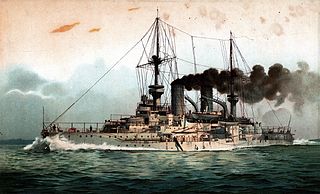
SMS Mecklenburg was the fifth ship of the Wittelsbach class of pre-dreadnought battleships of the German Imperial Navy. Laid down in May 1900 at the AG Vulcan shipyard in Stettin, Germany, she was finished in May 1903. Her sister ships were Wittelsbach, Zähringen, Wettin, and Schwaben; they were the first capital ships built under the Navy Law of 1898, championed by Admiral Alfred von Tirpitz. Mecklenburg was armed with a main battery of four 24-centimeter (9.4 in) guns and had a top speed of 18 knots.

SMS Wittelsbach was the lead ship of the Wittelsbach class of pre-dreadnought battleships, built for the Imperial German Navy. She was the first capital ship built under the Navy Law of 1898, brought about by Admiral Alfred von Tirpitz. Wittelsbach was laid down in 1899 at the Wilhelmshaven Navy Dockyard and completed in October 1902. She was armed with a main battery of four 24 cm (9.4 in) guns and had a top speed of 18 knots.

SMS Schwaben was the fourth ship of the Wittelsbach class of pre-dreadnought battleships of the German Imperial Navy. Schwaben was built at the Imperial Dockyard in Wilhelmshaven. She was laid down in 1900, and completed in April 1904. Her sister ships were Wittelsbach, Zähringen, Wettin and Mecklenburg; they were the first capital ships built under the Navy Law of 1898, championed by Admiral Alfred von Tirpitz. Schwaben was armed with a main battery of four 24-centimeter (9.4 in) guns and had a top speed of 18 knots.

SMS Elsass was the second of five pre-dreadnought battleships of the Braunschweig class in the German Imperial Navy. She was laid down in May 1901, launched in May 1903, and commissioned in November 1904, though an accident during sea trials delayed her completion until May 1905. She was named for the German province of Elsass, now the French region of Alsace. Her sister ships were Braunschweig, Hessen, Preussen and Lothringen. The ship was armed with a battery of four 28 cm (11 in) guns and had a top speed of 18 knots. Like all other pre-dreadnoughts built at the turn of the century, Elsass was quickly made obsolete by the launching of the revolutionary HMS Dreadnought in 1906; as a result, her career as a frontline battleship was cut short.
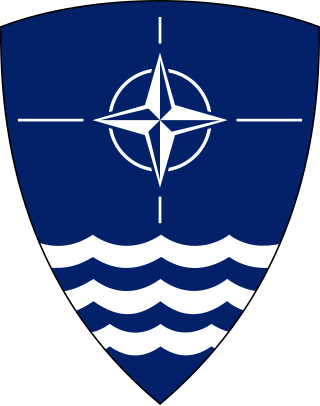
Allied Forces Baltic Approaches (BALTAP) was a Principal Subordinate Command (PSC) of the NATO Military Command Structure, with responsibility for the Baltic Sea area. It was in existence from 1962 to 2002 and consisted of the Danish Armed Forces, units of the West German Bundeswehr and allied wartime reinforcements.

U-36 (S186) is a Type 212A submarine of the German Navy. She is the sixth ship of the class to enter service.
Rainer Maria Brinkmann is a Vizeadmiral of the German Navy, and the current Deputy Inspector of the Navy. He previously served in fast attack craft units, and in staff positions, and has a degree in education from the University of the Bundeswehr Hamburg.
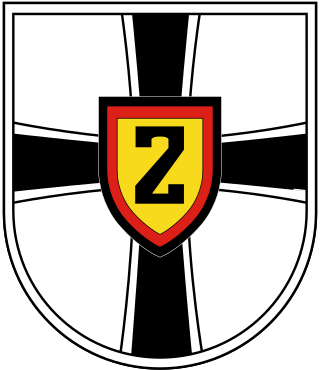
Einsatzflottille 2 is one of the three brigade-level units of the German Navy, in addition to Einsatzflottille 1 and the Naval Air Command. It is based in Wilhelmshaven, Lower Saxony, and is subordinated to Navy Command, based in Rostock.
In 1989 the Royal Navy was under the direction of the Navy Department in the UK Ministry of Defence. It had two main commands, CINCFLEET and Naval Home Command.
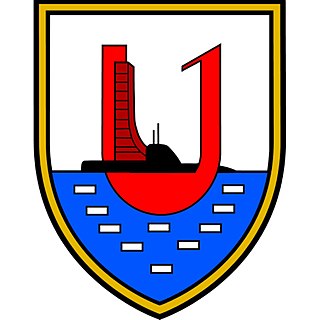
The 1. Ubootgeschwader is a submarine squadron of the German Navy. It is based at Eckernförde, Schleswig-Holstein, and forms part of Einsatzflottille 1, headquartered in Kiel.

Elbe (A511) is the lead ship of the Elbe-class replenishment ships of the German Navy.
















